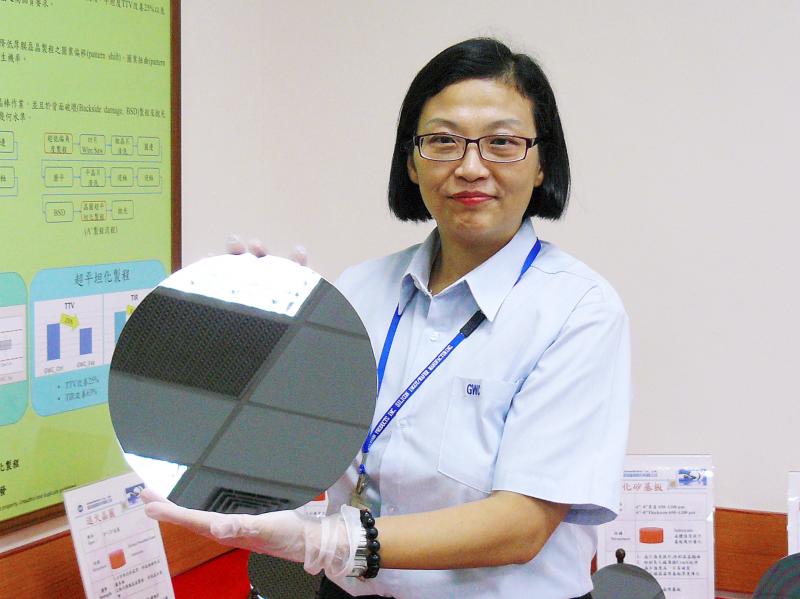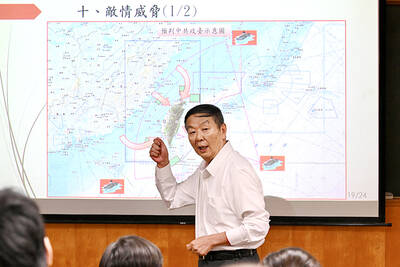GlobalWafers Co (環球晶圓) plans to start construction on a US$5 billion wafer fabrication facility in Texas in November, after passage of the US$52 billion Creating Helpful Incentives to Produce Semiconductors (CHIPS) for America Act.
The fab would be the largest of its kind in the US and one of the largest in the world, with a monthly capacity of 1.2 million wafers, GlobalWafers said, adding that the investment would be the first new fab in the US in more than 20 years and critical to closing a semiconductor supply chain gap.
The world’s No. 3 silicon wafer supplier said the project, which would have multiple stages, is to begin with an investment of about NT$55 billion (US$1.85 billion) to build a monthly capacity of 15,000 wafers.

Photo: CNA
The production is expected to begin in 2025, if everything goes smoothly, GlobalWafers said.
“This [the passage of the CHIPS Act] is the only factor we have no control over... The CHIPS Act funding is crucial for us. In other words, if the act’s passage is delayed for too long, we will certainly need to adjust for that. We have some contingency plans ready,” GlobalWafers chairwoman Doris Hsu (徐秀蘭) told a news briefing yesterday. “We cannot wait for a long time. We have secured a lot of long-term supply agreements from our customers.”
About 80 percent of the new manufacturing facility’s capacity has been booked, the company said.
To start construction in November, the act would need to pass before the US Congress’ August recess.
GlobalWafers said the government subsidies were one of the main reasons it opted to build the fab in Texas.
Funding from the US government would help to offset the high cost of construction in the US and alleviate some of the financial pressure in the initial operating stages, Hsu said.
The company was also drawn to the US because of rapidly growing demand from its customers there, Hsu said.
There are a substantial number of firms in the US semiconductor supply chain, from polysilicon suppliers, foundries and integrated devices manufacturers to chip design houses, she added.
The world’s major chipmakers, including Taiwan Semiconductor Manufacturing Co (台積電), GlobalFoundries Inc, Intel Corp, Samsung Electronics Co and Texas Instruments Inc, have announced plans to construct new factories in the US.
“With the global chip shortage and ongoing geopolitical concerns, GlobalWafers is taking this chance to address the issue of the resiliency of the US’ semiconductor supply chain by building an advanced node, state-of-the-art, 300mm silicon wafer factory,” Hsu said.
GlobalWafers has two fabs in the US, one in Texas and one in Missouri.
Separately, GlobalWafers said that the Ministry of Economic Affairs’ decision to increase the cost of electricity for industrial heavy users by 15 percent far exceeded what it had expected and would add to its operating costs.
GlobalWafers said it supports rate hikes and hopes that the increase would result in a stable, high-quality power supply.
The cost increase from the rate hike should be manageable, the company said, adding that it would step up power conservation measures and increase green energy adoption to minimize the impact.

RETHINK? The defense ministry and Navy Command Headquarters could take over the indigenous submarine project and change its production timeline, a source said Admiral Huang Shu-kuang’s (黃曙光) resignation as head of the Indigenous Submarine Program and as a member of the National Security Council could affect the production of submarines, a source said yesterday. Huang in a statement last night said he had decided to resign due to national security concerns while expressing the hope that it would put a stop to political wrangling that only undermines the advancement of the nation’s defense capabilities. Taiwan People’s Party Legislator Vivian Huang (黃珊珊) yesterday said that the admiral, her older brother, felt it was time for him to step down and that he had completed what he

ROLLER-COASTER RIDE: More than five earthquakes ranging from magnitude 4.4 to 5.5 on the Richter scale shook eastern Taiwan in rapid succession yesterday afternoon Back-to-back weather fronts are forecast to hit Taiwan this week, resulting in rain across the nation in the coming days, the Central Weather Administration said yesterday, as it also warned residents in mountainous regions to be wary of landslides and rockfalls. As the first front approached, sporadic rainfall began in central and northern parts of Taiwan yesterday, the agency said, adding that rain is forecast to intensify in those regions today, while brief showers would also affect other parts of the nation. A second weather system is forecast to arrive on Thursday, bringing additional rain to the whole nation until Sunday, it

CONDITIONAL: The PRC imposes secret requirements that the funding it provides cannot be spent in states with diplomatic relations with Taiwan, Emma Reilly said China has been bribing UN officials to obtain “special benefits” and to block funding from countries that have diplomatic ties with Taiwan, a former UN employee told the British House of Commons on Tuesday. At a House of Commons Foreign Affairs Committee hearing into “international relations within the multilateral system,” former Office of the UN High Commissioner for Human Rights (OHCHR) employee Emma Reilly said in a written statement that “Beijing paid bribes to the two successive Presidents of the [UN] General Assembly” during the two-year negotiation of the Sustainable Development Goals. Another way China exercises influence within the UN Secretariat is

CHINA REACTS: The patrol and reconnaissance plane ‘transited the Taiwan Strait in international airspace,’ the 7th Fleet said, while Taipei said it saw nothing unusual The US 7th Fleet yesterday said that a US Navy P-8A Poseidon flew through the Taiwan Strait, a day after US and Chinese defense heads held their first talks since November 2022 in an effort to reduce regional tensions. The patrol and reconnaissance plane “transited the Taiwan Strait in international airspace,” the 7th Fleet said in a news release. “By operating within the Taiwan Strait in accordance with international law, the United States upholds the navigational rights and freedoms of all nations.” In a separate statement, the Ministry of National Defense said that it monitored nearby waters and airspace as the aircraft